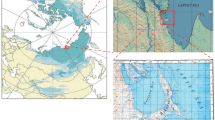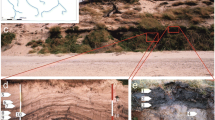Abstract—
The article presents the results of studying the spores and pollen preservation in soils of the permafrost zone in Yakutia (Kolyma Lowland, Bykovsky Peninsula, Yakutsk and its neighborhood). Data on the qualitative and quantitative composition of palynomorphs and on the patterns of their damage are discussed, and the mechanism of their cryogenic destruction is analyzed. Palynological residues with destruction of the chemical-biotic type (thinning of the walls, the formation of cavities as a result of the chemical action of microbes on them) are present singly or absent, which is probably due to the specificity of permafrost with a predominance of low temperatures throughout the year and a generally suppressed microbiological activity. Palynomorph damages of the physical type (ruptures and cracks) usually predominate. In samples from mineral horizons of loamy soils, the content of damaged palynological remains is 5–10%; in mineral horizons of sandy soil, it reaches 20%. In sandy soil, the content of unfrozen water films performing a cryoprotective role is low, and the palynomorphs are more susceptible to destruction by growing ice crystals during freezing. The large-size Gymnospermae pollen of Pinus and Larix is most susceptible to destruction. Damages are usually present on the dominant pollen of Poaceae and Betula sect. Nanae, as well as of Cyperaceae and Ericaceae. Few damage cases are characteristic of pollen grains of minor taxa: Salix, Duschekia, Asteraceae, Onagraceae, Ranunculaceae, Caryophyllaceae and of spores of Sphagnum and Bryales. There are no damages on pollen of herbs Valeriana, Polemonium, Artemisia, Chenopodiaceae, and Polygonaceae and on spores of Lycopodium, Diphasiastrum, Selaginella, and Polypodiaceae. The results can be used in the reconstruction of paleogeographic conditions for buried soils, as well as in the study of cryopreservation of biological objects in permafrost areas.






Similar content being viewed by others
REFERENCES
P. M. Anderson, A. V. Lozhkin, B. V. Belaya, and T. V. Stetsenko, “Modern spore–pollen spectra of lake sediments in the mountainous areas of the Kolyma and Indigirka basins,” in Quaternary Paleogeography of Beringia (Magadan, 2002), pp. 28–39 [in Russian].
E. V. Arinushkina, Handbook on the Chemical Analysis of Soils (Izd. Mosk. Univ., Moscow, 1962) [in Russian].
A. K. Vasil’chuk, “Specificity of the taphonomy of spores and pollen in the Arctic,” Izv. Ross. Akad. Nauk, Ser. Biol., No. 2, 240–252 (2005).
A. K. Vasil’chuk, Specific Features of the Formation of Palynological Spectra in the Permafrost Zone of Russia (Izd. Mosk. Univ., Moscow, 2005) [in Russian].
A. K. Vasil’chuk, “Regional and long-range transported pollen in tundra pollen spectra.” Izv. Ross. Akad. Nauk, Ser. Biol., No. 1, 1–12 (2005).
A. K. Vasil’chuk and Yu. K. Vasil’chuk, “Pollen spectra of glaciers in the Polar Urals,” Arktika Antarktika, No. 4, 1–14 (2020).
S. V. Gubin, “Pedogenesis: a component of the mechanism of formation of the Late Pleistocene ice complex,” Kriosfera Zemli 6 (3), 82–91 (2002).
S. V. Gubin and O. G. Zanina, “Changes in the soil cover in the course of the formation of the ice complex sediments on the Kolyma Lowland,” Kriosfera Zemli 17 (4), 48–56 (2013).
S. V. Gubin and A. V. Lupachev, “Approaches towards separation and study of buried soils in frozen sediments of the ice complex,” Kriosfera Zemli 16 (2), 79–84 (2012).
V. Ya. Kats and R. V. Fedorova, “On the possibility of using palynological analysis in studies of the high-latitude Arctic regions,” Byul. Mosk. O-va Ispyt. Prirody. Otd. Biol. 88 (2), 63–70 (1983).
D. A. Lopatina and O. G. Zanina, “Subrecent spore–pollen spectra from the lower reaches of the Kolyma River and their significance for the reconstruction of Quaternary history of this region,” Stratigr. Geol. Korrelyatsiya, No. 2, 103–112 (2016).
D. A. Lopatina and O. G. Zanina, “Conditions of formation of MIS 3 plaeosols in the Kolyma Lowland according to palynological and phytolithic methods.” Stratigr. Geol. Korrelyatsiya 28 (3), 1–14 (2020).
G. V. Musina and R. S. Sakhibgareev, “Destruction of the shells of pollen and spores in the course of lithogenesis,” in Stratigraphy and Correlation of Sediments using Palynological Methods (UNTs AN SSSR, Sverdlovsk, 1983), pp. 154–160 [in Russian].
Paleopalinology, Ed. by by I.M. Pokrovskaya (Nedra, Leningrad, 1966), Vol. I [in Russian].
M. A. Petros’yants, N. S. Ovnatova, and G. V. Mukhina, “Microfossils in geological practice and their role in determination of the conditions of ancient sedimentation,” Itogi Nauki tekhn., Ser. Obshchaya Geol., Vol. 27 (Moscow, 1990) [in Russian].
Palynological Analysis, ed. by A. N. Krishtofovich (Gosgeolizdat, Moscow, 1950) [in Russian].
E. A. Rashke and L. A. Savel’eva, “Subrecent spore–pollen spectra and modern vegetation of the Lena Delta, Russian Arctic.” Sibirsk. Ekol. Zh., No. 4, 456–472 (2017).
O. V. Rudenko, A. K. Vasil’chuk, and V. V. Enina, “Comparative characterization of the composition of subrecent pollen spectra in bottom sediments of the Laptev Sea and ice complexes of Siberian Arctic,” Arktika Antarktika, No. 3, 1–16 (2017).
S. N. Tyuremnov and N. A. Berezina, “Preservation and destruction of pollen: an important factor of the formation of spore–pollen spectra,” in Methodological Problems of Palynology. Proc. III Conf. (Moscow, 1973), pp. 5–8 [in Russian].
V. V. Ukraintseva and I. N. Pospelov, “On the relationships between the composition of vegetation and spore–pollen spectra in surface soil samples from the mouth of Olen’ya River, Taimyr Peninsula,” Izv. Ross. Akad. Nauk, Ser. Geograf., No. 3, 97–109 (2006).
D. G. Fedorov-Davydov, S. P. Davydov, A. I. Davydova, S. A. Zimov, N. S. Mergelov, V. E. Ostroumov, V. A. Sorokovikov, A. L. Kholodov, I. A. Mitroshin, “Spatiotemporal patterns of seasonal soil thawing in the north of the Kolyma Lowland,” Kriosfera Zemli 8 (4), 15–26 (2004).
D. G. Fedorov-Davydov, S. P. Davydov, A. I. Davydova, D. G. Shmelev, V. E. Ostroumov, A. L. Kholodov, V. A. Sorokovikov, “Thermal state of soils in northern Yakutia,” Kriosfera Zemli 22 (3), 52–66 (2018).
D. G. Fedorov-Davydov, S. P. Davydov, A. I. Davydova, V. E. Ostroumov, A. L. Kholodov, V. A. Sorokovikov, D. G. Shmelev, “Temperature regime of soils in northern Yakutia,” Kriosfera Zemli 22 (4), 15–24 (2018).
A. V. Shatilovich, L. A. Shmakova, S. V. Gubin, and D. A. Gilichinskii, “Viable protozoans in the Arctic permafrost,” Kriosfera Zemli 14 (2), 69–78 (2010).
E. V. Shein and L. O. Karpachevskii (Eds.), Theories and Methods of Soil Physics (Grif i Ko, Moscow, 2007) [in Russian].
P. De Klerk, A. Teltewskoi, M. Theuerkauf, and H. Joosten, “Vegetation patterns, pollen deposition and distribution of non-pollen palynomorphs in an ice-wedge polygon near Kytalyk (NE Siberia), with some remarks on Arctic Pollen morphology,” Polar Biol. 37, 1393–1412 (2014).
P. De Klerk, M. Theuerkauf, and H. Joosten, “Vegetation, recent pollen deposition, and distribution of some non-pollen palynomorphs in a degrading ice-wedge polygon mire complex near Pokhodsk (NE Siberia), including size-frequency analyses of pollen attributable to Betula,” Rev. Palaeobot. Palynol. 238, 122–143 (2017).
D. Gilichinsky, V. S. Soina, and M. A. Petrova, “Cryoprotective properties of water in the earth cryolithosphere and its role in exobiology,” in Orig. Life Evol. Biosph. 23, 65–75 (1993).
R. Gluckler, U. Herzschuh, S. Kruse, A. Andreev, SA. Vyse, B. Winkler, B. Biskaborn, L. Pestryakova, E. Dietze, “Wildfire history of the boreal forest of south-western Yakutia (Siberia) over the last two millennia documented by a lake-sediment charcoal record,” Biogeosciences 18, 4185–4209 (2021).
J. Klemm, U. Herzschuh, M. Pisaric, R. Telford, B. Heim, L. A. Pestryakova, “A Pollen-climate transfer function from the tundra and taiga vegetation in Arctic Siberia and its applicability to a holocene record,” Palaeogeogr. Palaeoclimatol. Palaeoecol. 386, 702–713 (2013).
J. Murton, T. Goslar, M. Edwards, M. Bateman, P. Danilov, G. Savvinov, S. Gubin, et al., “Palaeoenvironmental interpretation of yedoma silt (Ice Complex) deposition as cold-climate loess, Duvanny Yar, Northeast Siberia,” Permafrost Perigl. Process 26, 208–288 (2015).
Funding
The collection of factual material and studies into the preservation of palynomorphs were supported by the Russian Foundation for Basic Research, project no. 20-05-00559-A. Soil samples were analyzed with the financial support of the Russian Foundation for Basic Research, project no. 19-29-05003 MK. The study of modern soils of Yakutia was carried out within the framework of the state assignment of the Institute of Physicochemical and Biological Problems of Soil Science of the Russian Academy of Sciences, and the statistical analysis of palynological data and synthesis of the materials were performed within the framework of the state assignment of the Geological Institute of the Russian Academy of Sciences.
Author information
Authors and Affiliations
Corresponding author
Ethics declarations
The authors declare that they have no conflicts of interest.
Additional information
Translated by D. Konyushkov
SUPPLEMENTARY MATERIALS
Table S1 . Description of studied soils
Supplementary Information
Rights and permissions
About this article
Cite this article
Lopatina, D.A., Zanina, O.G. & Fedorov-Davydov, D.G. Features of Spore and Pollen Preservation in Permafrost-Affected Soils of Yakutia. Eurasian Soil Sc. 55, 1016–1027 (2022). https://doi.org/10.1134/S1064229322080099
Received:
Revised:
Accepted:
Published:
Issue Date:
DOI: https://doi.org/10.1134/S1064229322080099




